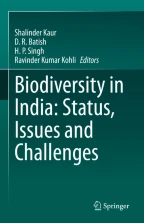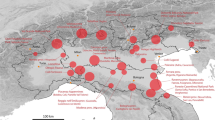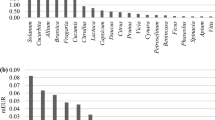Agricultural Crop Diversity: Status, Challenges, and Solutions

India is rich in biological diversity, being one of the 17 mega-biodiverse countries in the world. It has an amazing range of habitats available in its 10 + 1 bio-geographic zones (Singh 2017a, b), habiting about 20,141 taxa of higher plants (angiosperms) with 17,926 species belonging to 2991 genera and 251 families, representing approximately 7% of the described higher plant species in the world (Karthikeyan 2009). As per archaeological evidence, the Indian Subcontinent has played an important role in the origin and evolution of agriculture from the hunters-gatherers stage to domiculture and to settled agriculture exploiting both flora and fauna. These efforts led to the evolution of the Indus Valley Civilization developed and flourished nearly 5000 years ago (3300–1300 BCE; mature period 2600–1900 BCE), Vedic Civilization (1500–500 BCE), Mahajanapada (600–400 BCE), etc., as gleaned from the findings of numerous archaeological sites across the country. Recent studies have shown that the process of origin and evolution of agriculture predominantly occurred at 21 agricultural biodiversity heritage sites, spread over the subcontinent with domestication, adaption, and cultivation of many crop species suited to diverse ecologies offered by the subcontinent (Singh 2015). These fell parallel to 21 agro-ecological zones, identified for the subcontinent (Sehgal et al. 1992) with a rich diversity of crops and genetic diversity in adapted crop species (Fig. 11.1), throughout ecological zones and beyond, under more than 120 production systems. Significant progress has been made in the collection, characterization, conservation, and utilization of crop diversity in crop improvement. However, there remain gaps needing new approaches for effective management and sustainable use, including bioinformatics, genomics and molecular breeding, and engineering cultigens meeting the emerging challenges.
This is a preview of subscription content, log in via an institution to check access.
Access this chapter
Subscribe and save
Springer+ Basic
€32.70 /Month
- Get 10 units per month
- Download Article/Chapter or eBook
- 1 Unit = 1 Article or 1 Chapter
- Cancel anytime
Buy Now
Price includes VAT (France)
eBook EUR 117.69 Price includes VAT (France)
Softcover Book EUR 158.24 Price includes VAT (France)
Hardcover Book EUR 158.24 Price includes VAT (France)
Tax calculation will be finalised at checkout
Purchases are for personal use only
Similar content being viewed by others

An updated checklist of plant agrobiodiversity of northern Italy
Article Open access 24 March 2022

On-farm crop diversity, conservation, importance and value: a case study of landraces from Western Ghats of Karnataka, India
Article Open access 10 May 2024

An inventory of crop wild relatives of the Maltese Islands
Article 20 June 2022
References
- Ahlawat SP, Pandey A, Bhatt KC, Pradheep K, Rathi RS, Semwal DP, Soyimchiten NS, Kumar P, Panwar NS, Gupta R, Dhariwal OP, Sharma SK (2019) Collecting plant genetic resources for conservation, research and use. ICAR- National Bureau of Plant Genetic Resources, Pusa Campus, New Delhi. http://www.nbpgr.ernet.inGoogle Scholar
- Arora RK, Nayar ER, Pandey A (2006) Indian center of floristic and economic plant diversity. In: Singh Anurudh K, Srinivasan K, Saxena S, Dhillon BS (eds) Hundred years of plant genetic resources management in India. National Bureau of Plant Genetic Resources (ICAR), Pusa Campus, New Delhi, pp 1–28 Google Scholar
- Biological Diversity Act (2002) Biological Diversity Rules (2004). National Biodiversity Authority, Government of India, Chennai, India, pp 57 Google Scholar
- Bisht IS, Mahajan RK, Patel DP (1998) The use of characterization data to establish the Indian Mungbean core collection and assessment of genetic diversity. Genet Resour Crop Evol 45:127–133 ArticleGoogle Scholar
- Brar DS (2005) Broadening the gene pool of rice through introgression from wild species. In: Toriyama K, Heong KL, Hardy B (eds) Rice is life: scientific perspective for 21 century. Proceeding of the world rice research conference, Tokyo and Tsukuba, Japan, 4–7 Nov 2004. IRRI, Philippines, pp 157–160 Google Scholar
- Brown AHD (1995) The core collection at the crossroads. In: Hodgkin T, Brown AHD, van Hintum ThJL, Morales EAV (eds) Core collections of plant genetic resources. Wiley, Chichester, pp 3–19 Google Scholar
- Dalmacio R, Brar DS, Ishii T, Sitch LA, Virmani SS, Khush GS (1995) Identification and transfer of a new cytoplasmic male sterility source from Oryza perennis into indica rice (O. sativa). Euphytica 82:221–225 ArticleGoogle Scholar
- De Candolle A (1883) In: Laffitte J (ed) Origine des plantes cultivées, vol VIII. Germer Baillière, Paris, p 379 Google Scholar
- Duvick D (1984) Genetic diversity in major farm crops on the farm and in reserve. Econ Bot 38:161–178 ArticleGoogle Scholar
- FAO Resolution 8/83 (1983) The international undertaking on plant genetic resources (IU), adopted by FAO at 22nd Session of the Conference (Rome, 5 - 23 November 1983) Google Scholar
- GCDT (Global Crop Diversity Trust) (2006) Guidelines for the development of crop conservation strategies and guidelines for the development of regional conservation strategies. http://www.croptrust.org/main/identifyingneed.php?itemid=513; http://www.croptrust.org/main/identifyingneed.php?itemid=512
- Hajjar R, Hodgkin T (2007) The use of wild relatives in crop improvement: a survey of developments over the last 20 years. Euphytica 156:1–13 ArticleGoogle Scholar
- Harlan JR (1975) Crops and man, 2nd edn. American Society of Agronomy, Madison, WI Google Scholar
- ITPGRFA (International Treaty on Plant Genetic Resources for Food and Agriculture) Secretariat FAO Rome (2011) Introduction to the international treaty on plant genetic resources for food and agriculture. FAO, Rome, p 155 Google Scholar
- Jackson M (1994) Preservation of rice strains. Nature (London) 371:470 ArticleGoogle Scholar
- Karthikeyan S (2009) Flowering plants of India in 19th and 21st centuries – a comparison. In: Krishnan S, Bhat DJ (eds) Plant and fungal biodiversity and bioprospecting. Goa University, Goa, pp 19–30 Google Scholar
- Kole C (ed) (2011) Wild crop relatives: genomics and breeding resources, comprehensive, 10-vol-work on the subject. Springer, Berlin Google Scholar
- Mahajan RK, Bisht IS, Agrawal RC, Rana RS (1996) Studies on south Asian okra collection: a methodology for establishing a representative core set using characterization data. Genet Resour Crop Evol 43:244–255 ArticleGoogle Scholar
- Maxted N, Kell SP (2009) Establishment of a global network for the in situ conservation of crop wild relatives: status and needs. FAO, Rome Google Scholar
- Mishra SK, Singh M, Kumar A, Rana JC (2006) Germplasm characterization, evaluation and utilization. In: Singh Anurudh K, Srinivasan K, Saxena S, Dhillon BS (eds) Hundred years of plant genetic resources management in India. National Bureau of Plant Genetic Resources (ICAR), Pusa Campus, New Delhi, pp 133–170 Google Scholar
- Nagoya Protocol (2010) Nagoya Protocol on access to genetic resources and the fair and equitable sharing of benefits arising from their utilization to the Convention on Biological Diversity. A supplementary agreement to the 1992 Convention on Biological Diversity (CBD), Nagoya, Japan, pp 25 Google Scholar
- Parthasarathy N (1954) Report of the international Rice hybridization project for the period of June 1952 - May 1954. IRC Newslett 11:17–20 Google Scholar
- PPVFR Act (The Protection of Plant Variety and Farmers Right Act) (2001) Universal Law Publishing Co Pvt. Ltd. C-FF-!A, Dilsukhush Industrial Estate, Delhi-110 033, India. http://agricoop.nic.in/PPV&FR%20Act,%202001.pdf
- Pritchard JK, Stephens M, Donnelly P (2000) Inference of population structure using multilocus genotype data. Genetics 155:945–959 ArticleCASGoogle Scholar
- Pushpangadan P, George V, Ijinu TP, Chithra MA (2018) All India coordinated research project on ethnobiology and genesis of ethnopharmacology research in India including benefit sharing. Ann Phytomed 7:5–12. https://doi.org/10.21276/ap.2018.7.1.2ArticleGoogle Scholar
- Rao CK, Geetha BL, Suresh G (2003) Red list of threatened vascular plant species in India. ENVIS, Botanical Survey of India, Ministry of Environment and Forests, New Delhi Google Scholar
- Reem H, Toby H (2007) The use of wild relatives in crop improvement: a survey of developments over the last 20 years. Euphytica 156:1–13 ArticleGoogle Scholar
- Richharia RH, Misro B (1959) The japonica x Indica hybridization project in Rice – an attempt for increased rice production. J Biol Sci (Bombay) 2:35–47 Google Scholar
- Rick CM (1979) Potential improvement of tomatoes by controlled introgression of genes from wild species. In: Proceedings of the conference broadening the genetic base of crops. Wageningen Pudoc, Wageningen Google Scholar
- Saraswat KS (1992) Archaeobotanical remains in ancient culture and socio-economical dynamics of the Indian subcontinent. Palaeobotanist 40:514–545 Google Scholar
- Saxena KB, Kumar RV, Srivastava N, Shiying B (2005) A cytoplasmic-nuclear male-sterility system derived from a cross between Cajanus cajanifolius and C. cajan. Euphytica 145:291–296 ArticleGoogle Scholar
- Sehgal JL, Mandal DK, Mandal C, Vadivelu S (1992) Agroecological regions of India. NBSS & LUP technical bulletin no. 24, 2nd edn. National Bureau of Soil Survey and Land Use Planning, Indian Council of Agricultural Research, Nagpur, Maharashtra Google Scholar
- Singh AK (1995) Genetic diversity and its role in the improvement of cereals, pulses and oil seeds. In: Johri BM (ed) History and progress of botany in India. Modern Period Oxford, Delhi, pp 241–267 Google Scholar
- Singh AK (2015) Agricultural biodiversity heritage sites and systems in India. Asian Agri-History Research Foundation, Secunderabad, Telangana, p 467 Google Scholar
- Singh AK (2016) Exotic ancient plant introductions: part of Indian ‘Ayurveda’ medicinal system. Plant Genet Res Characterization Utilization 14:356–369 ArticleGoogle Scholar
- Singh AK (2017a) Revisiting the status of cultivated plant species agrobiodiversity in India: an overview. Proc Indian Natn Sci Acad 83:151–174 Google Scholar
- Singh AK (2017b) Wild relatives of cultivated plants in India: a reservoir of alternative genetic resources and more. Springer Nature Singapore Pte Ltd., Singapore, p 310 BookGoogle Scholar
- Singh AK, Nigam SN (2017) Ancient alien crop introductions integral to Indian agriculture: an overview. Proc Indian Natn Sci Acad 83:549–568 Google Scholar
- Singh AK, Rana RS, Mal B, Singh B, Agrawal RC (2013) Cultivated plants and their wild relatives in India– an inventory. Protection of Plant Varieties and Farmers’ Rights Authority, New Delhi, p 251 Google Scholar
- Singh RB, Khanna-Chopra R, Singh AK, Gopala Krishnan S, Singh NK, Prabhu KV, Singh AK, Bansal KC, Mahadevappa M (2016) Chapter 1. Crop science. In: Singh RB (ed) 100 years of agricultural sciences in India. National Academy of Agricultural Sciences, New Delhi, pp 1–98 Google Scholar
- Tikka SBS, Parmar LD, Chauhan RM (1997) First record of cytoplasmic-genic male-sterility system in pigeonpea and its related wild species. J Plant Physiol 137:64–71 Google Scholar
- Umakanth B, Vishalakshi B, Sathish Kumar P, Rama Devi SJS, Bhadana VP, Senguttuvel P, Kumar S, Sharma SK, Sharma PK, Prasad MS, Madhav MS (2017) Diverse rice landraces of North-East India enables the identification of novel genetic resources for Magnaporthe resistance. Front Plant Sci 8:1500. https://doi.org/10.3389/fpls.2017.01500ArticlePubMedPubMed CentralGoogle Scholar
- UNCED/CBD (1992) United Nations conference on environment and development. Convention on Biological Diversity, Rio de Janeiro Google Scholar
- Upadhyaya HD (2015) Establishing core collections for enhanced use of germplasm in crop improvement. Ekin J Crop Breed Genet 1:1–12. http://dergipark.gov.tr/ekinjournal/issue/22784/243174Google Scholar
- Vavilov NI (1935) The phytogeographical basis of plant breeding. In: Love D (ed) (Transl) Origin and geography of cultivated plants, vol 1. University of Cambridge Press, Cambridge, pp 330–336, 1992 Google Scholar
- Vermeulen SJ (2014) Climate change, food security and small-scale producers. CCAFS info brief. CGIAR research program on climate change, agriculture and food security (CCAFS). Copenhagen, Denmark. www.ccafs.cgiar.org
- Xian-Hua S, Song Y, Ren-Liang H, Shan Z, Hong-Liang X, Lin-On Jun S (2013) Development of novel cytoplasmic male sterile source from Dongxiang Wild Rice (Oryza rufipogon). Rice Sci 20:379–382 ArticleGoogle Scholar
- Zeven AC, De Wet JMJ (1982) Dictionary of cultivated plants and their regions of diversity. Centre of Agricultural Publishing and Documentation, Wageningen, p 219 Google Scholar
Author information
Authors and Affiliations
- Division of Germplasm Conservation, National Bureau of Plant Genetic Resources, Indian Council of Agricultural Research, New Delhi, India Anurudh K. Singh
- ICRISAT, Patancheru, Telangana, India Anurudh K. Singh
- Anurudh K. Singh




